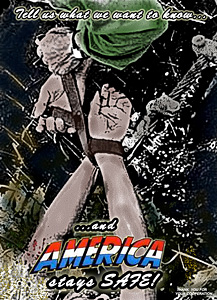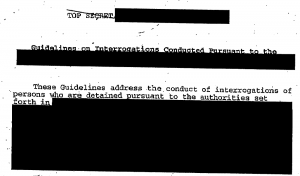Inadequate Briefing on the Drone Program Shows Congress Hasn’t Fixed the Gloves Come Off MON
I need to finish my series (post 1, post 2, post 3, post 4, post 5, post 6) on the Obama Administration’s efforts to hide what I’ve dubbed the “Gloves Come Off” Memorandum of Notification. As I described, the MON purportedly gave CIA authority to do a whole slew of things, but left it up to the CIA to decide how to implement the programs Bush authorized. And rather than giving the Intelligence Committees written notification of the details of the programs, CIA instead gave just the Gang of Four deceptive briefings on the programs, which not only gave a misleading sense of the programs, but also prevented Congress from being able to limit the programs by refusing to fund the activities.
Yet, as MadDog and I were discussing in the comments to this post, these aspects of the MON set up did not entirely elude the attention of Congressional overseers. In fact, the very first Democrat to be briefed that torture had been used (remember, Pelosi got briefed it might be used prospectively) asked questions that went to the heart of the problem with the structure of the MON.
The CIA won’t tell Jane Harman whether the President approved torture from a policy standpoint
Jane Harman was first briefed on the torture program, with Porter Goss, on February 5, 2003. We don’t actually know what transpired in that briefing because CIA never finalized a formal record of the briefing. But five days after the briefing, Harman wrote a letter to CIA General Counsel Scott Muller. In addition to using a word for the torture program CIA has redacted and objecting to the destruction of the torture tapes, Harman asked questions that should have elicited a response revealing the Gloves Come Off MON was what authorized the torture program.
It is also the case, however, that what was described raises profound policy questions and I am concerned about whether these have been as rigorously examined as the legal questions. I would like to know what kind of policy review took place and what questions were examined. In particular, I would like to know whether the most senior levels of the White House have determined that these practices are consistent with the principles and policies of the United States. Have enhanced techniques been authorized and approved by the President?
The whole point of a MON, after all, was to get the President on the record asserting that the programs authorized by it are “necessary to support identifiable foreign policy objectives of the United States and [are] important to the national security of the United States.” Here, Harman was asking whether the President was part of a policy review on torture.
Just over a week after Harman sent this letter, the CIA met with the White House to decide how to respond to Harman’s letter.
Now, granted, Harman’s question did not explicitly ask about a MON. But the CIA did not even answer the question she did ask. Muller basically told her policy had “been addressed within the Executive Branch” without saying anything about Bush’s role in it.
While I do not think it appropriate for me to comment on issues that are a matter of policy, much less the nature and extent of Executive Branch policy deliberations, I think it would be fair to assume that policy as well as legal matters have been addressed within the Executive Branch.
Kudos to Harman for actually asking questions. But at this point, she should have known that there was something funky about the legally required MON for the torture program.
Two years later, she was still trying to get answers about the MON. In her third briefing on torture (PDF 29-31; see also this post)–on July 13, 2004, which was almost 3 weeks after Harman should have received the Inspector General Report–Muller first claimed that the legal foundation for the torture program were the Bybee Memos (he provided this explanation in the context of explaining considerations of whether the program complied with Article 16 of the Convention against Torture).
The General Counsel said that the effort was working effectively under the DOJ 1 August 2002 memo which was the legal foundation for the debriefings and interrogations.
But later in the briefing, Harman appears to have noted that the MON didn’t authorize torture, it only authorized capture and detention.
Rep. Harman noted that the [redaction] did not specify interrogations and only authorized capture and detention. Read more →


